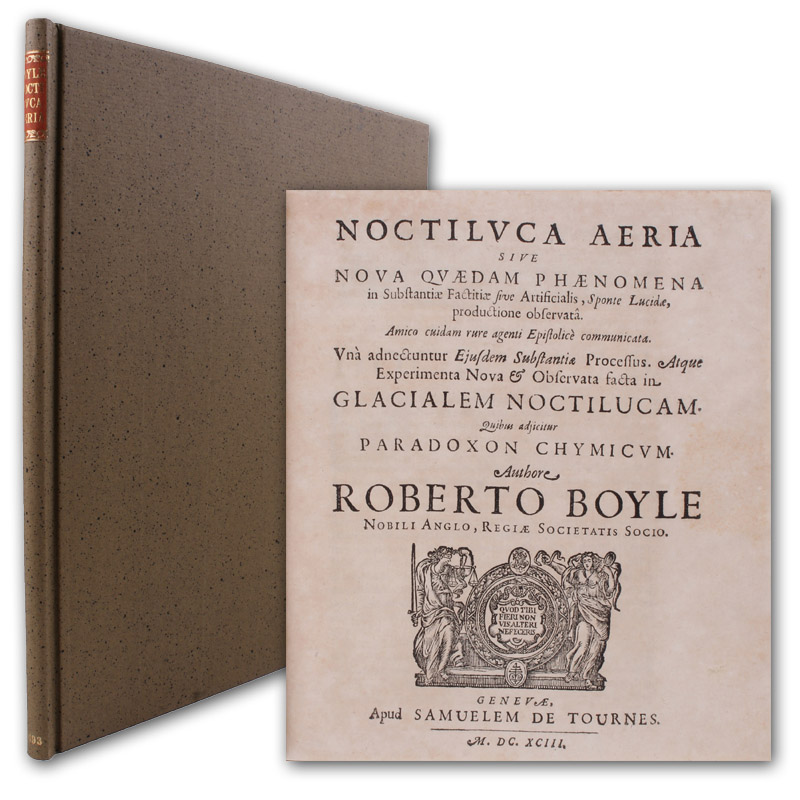112941-01
Noctiluca aeria sive nova quaedam phaenomena in substantiae factitiae sive artificialis, sponte lucidae productione observata.
Genf, De Tournes, 1693. - (21 x 18 cm). 108 S. Moderner Pappband im Stil der Zeit.
Dritte lateinsche Ausgabe seines "Aerial and Icy Noctiluca". - "As Professor E. Newton Harvey has brought out in such vivid fashion, the phenomenon of spontaneous luminescence had engaged the attention of mankind since prehistoric times... Robert Boyle was the first to establish the fact that the air contained something essential for 'shining wood' to shine, since he found on 29 October 1667 that the glow of such luminous wood disappears completely when air is made tenuous in an exhaustion chamber. This important disclosure was promptly communicated in the 'Philosophical Transactions' for 6 January 1667/8. Boyle went on studying the phenomenon, which meanwhile had been used by wandering showmen such as J. D. Krafft who demonstrated his 'kalte Feuer' to various royal personages including Charles II. Boyle witnessed the performance and was stimulated by it to pursue the subject farther, evidently having dropped it nearly ten years earlier. It was during these efforts that he was led to isolate phosphorus which had been independently isolated by the German chemist K. Brand (or Brandt) in 1667. Boyle then published his two celebrated tracts, the first on 'Aerial Noctiluca', as he called it - the 'stuff' that gives fireflies their glow (1680) - and 'Icy Noctiluca', which he believed to be phosphorus itself (1681/2)" (Fulton). - Stellenweise etwas braunfleckig, sonst gut erhalten. - Fulton 142; Harvey, A history of luminescence S. 427ff.
Noctiluca aeria sive nova quaedam phaenomena in substantiae factitiae sive artificialis, sponte lucidae productione observata.
Genf, De Tournes, 1693. - (21 x 18 cm). 108 S. Moderner Pappband im Stil der Zeit.
Dritte lateinsche Ausgabe seines "Aerial and Icy Noctiluca". - "As Professor E. Newton Harvey has brought out in such vivid fashion, the phenomenon of spontaneous luminescence had engaged the attention of mankind since prehistoric times... Robert Boyle was the first to establish the fact that the air contained something essential for 'shining wood' to shine, since he found on 29 October 1667 that the glow of such luminous wood disappears completely when air is made tenuous in an exhaustion chamber. This important disclosure was promptly communicated in the 'Philosophical Transactions' for 6 January 1667/8. Boyle went on studying the phenomenon, which meanwhile had been used by wandering showmen such as J. D. Krafft who demonstrated his 'kalte Feuer' to various royal personages including Charles II. Boyle witnessed the performance and was stimulated by it to pursue the subject farther, evidently having dropped it nearly ten years earlier. It was during these efforts that he was led to isolate phosphorus which had been independently isolated by the German chemist K. Brand (or Brandt) in 1667. Boyle then published his two celebrated tracts, the first on 'Aerial Noctiluca', as he called it - the 'stuff' that gives fireflies their glow (1680) - and 'Icy Noctiluca', which he believed to be phosphorus itself (1681/2)" (Fulton). - Stellenweise etwas braunfleckig, sonst gut erhalten. - Fulton 142; Harvey, A history of luminescence S. 427ff.
750 €

